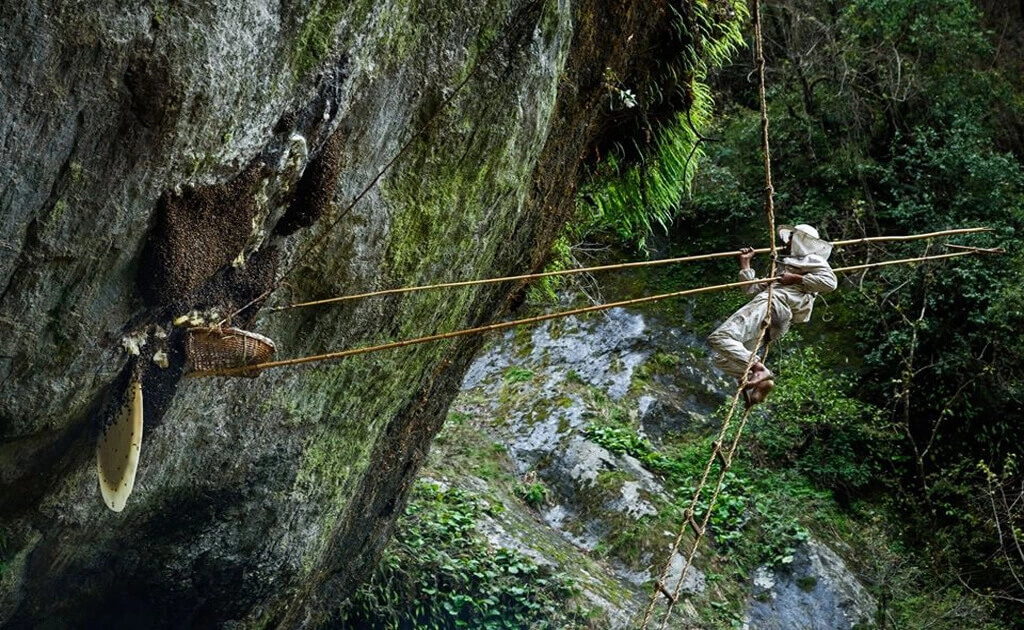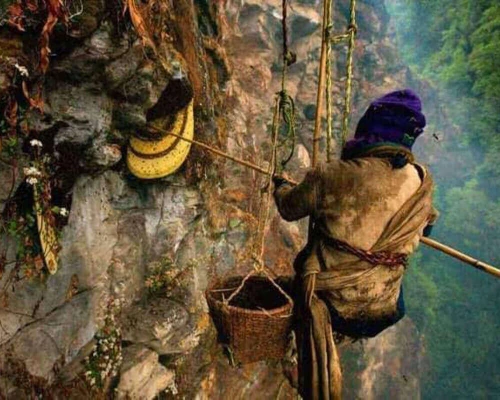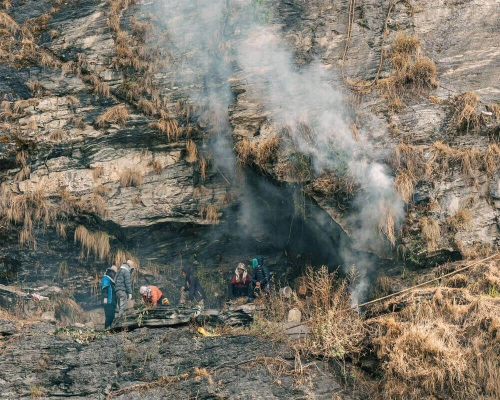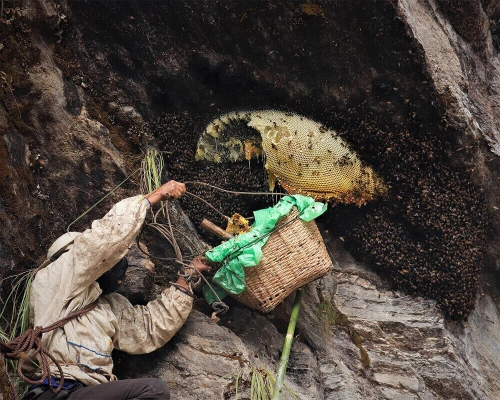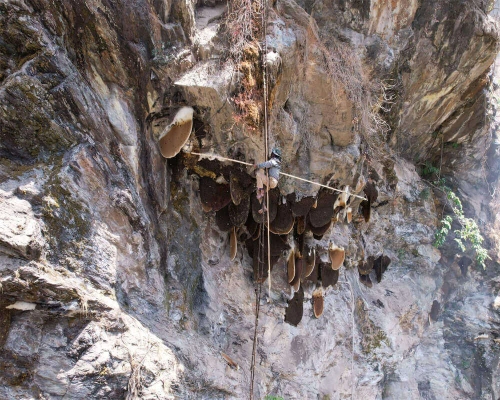Best Season for Mad Wild Honey Hunting Tour in Nepal
The best season for experiencing the mad wild honey hunting tour in Nepal is during spring, particularly from mid-April to early May. This time of year, offers the most favorable conditions, with warm weather, blooming rhododendron forests, and heightened activity from the giant Himalayan bees that produce the famed hallucinogenic "mad honey." The spring bloom influences the potency of the honey, making it especially sought after. A secondary season occurs in autumn, from November to December, when cooler temperatures and dry conditions make cliff climbing safer, though the honey may be less intense in effect. Both seasons provide a rare and thrilling opportunity to witness this ancient tradition, where skilled honey hunters scale towering cliffs using handmade ropes and ladders, risking their lives to harvest nature’s wild nectar.
Accommodations During Mad Wild Honey Hunting Tour in Nepal
Comfortable and culturally immersive accommodations are arranged throughout the Mad Wild Honey Hunting Tour in Nepal. At the beginning and end of the journey, guests stay in standard hotels in Kathmandu, typically in twin-sharing rooms, offering a peaceful retreat to relax and prepare. During the honey hunting adventure, accommodations shift to local guesthouses or traditional homestays nestled in rural villages. These stays provide a unique opportunity to experience the warm hospitality of local communities and gain deeper insight into their way of life. Though simple, the guesthouses and homestays are clean and welcoming, ensuring travelers feel at home while being part of this extraordinary cultural tradition.
Foods and Drinks for Mad Wild Honey Hunting Tour in Nepal
Throughout the Mad Wild Honey Hunting Tour in Nepal, travelers enjoy a nourishing and authentic culinary experience. While on the tour, three daily meals breakfast, lunch, and dinner are provided, featuring traditional Nepali dishes like dal bhat, seasonal vegetables, and local breads such as roti or sel roti. Meals in village settings are often made with fresh, organic ingredients sourced locally, offering a true taste of rural Nepal. Drinks include herbal teas, boiled water, and occasionally milk-based beverages. In some regions, guests may be offered traditional fermented drinks like tongba or chyang, depending on local customs. In Kathmandu, only breakfast is typically included, giving travelers the chance to explore the city's vibrant food scene independently. Whether in the hills or the capital, the food and drink offerings enhance the cultural depth of the journey.
Transportation Facility During Mad Wild Honey Hunting Tour in Nepal
Transportation throughout the Mad Wild Honey Hunting Tour is arranged with comfort and convenience in mind. The journey begins and ends in Kathmandu, and travel to the honey hunting regions is conducted via private jeep, ensuring a smooth and flexible ride across Nepal’s rugged terrain. This mode of transport allows travelers to enjoy scenic countryside views while maintaining a relaxed pace. Whether navigating winding mountain roads or reaching remote village trails, the private jeep provides a reliable and comfortable way to access the heart of the honey hunting experience
Guides for Mad Wild Honey Hunting Tour in Nepal
The Mad Wild Honey Hunting Tour in Nepal is led by experienced, licensed, English-speaking guides who are well-versed in both trekking and cultural interpretation. These guides accompany travelers throughout the journey, offering insights into local customs, landscapes, and the ancient honey-hunting tradition. In addition to the trekking guide, the tour includes a honey-hunting expert and crew local specialists who have inherited the skill of harvesting wild honey from towering cliffs using handmade ropes and ladders. Their deep knowledge and fearless technique make the experience both safe and unforgettable. The guides also carry a well-equipped medical kit, ensuring safety and preparedness throughout the adventure.
Driver for Mad Wild Honey Hunting Tour in Nepal
The Mad Wild Honey Hunting Tour is supported by a skilled and professional driver who ensures a safe and comfortable journey throughout the trip. Travel between destinations is conducted in a private jeep, allowing for flexibility and ease across Nepal’s diverse terrain. The driver is familiar with the routes leading to remote honey-hunting areas and is attentive to both road conditions and passenger comfort. With a calm demeanor and local knowledge, the driver plays a quiet but essential role in making the adventure smooth and enjoyable.
Safety Precautions for Mad Wild Honey Hunting Tour in Nepal
Health and safety are a top priority during the Mad Wild Honey Hunting Tour. While travelers don’t climb cliffs themselves, they observe expert Gurung honey hunters in action from safe vantage points, with protective gear and safety briefings provided. Encounters with giant Himalayan bees are managed carefully, and those with allergies should inform the team in advance. Mad honey tasting is guided and limited to safe amounts due to its natural neurotoxins. Travel insurance is highly recommended, and guides carry basic first aid kits. The tour also respects local rituals and supports eco-friendly harvesting, making it both adventurous and culturally mindful.
Insurance for Mad Wild Honey Hunting Tour in Nepal
Travel insurance is strongly recommended for anyone participating in the Mad Wild Honey Hunting Tour in Nepal. This unique adventure takes you deep into the rugged hills of central Nepal, where you'll witness indigenous Gurung tribesmen scale towering cliffs to harvest wild honey from giant bee colonies a thrilling yet physically demanding experience. The tour often involves trekking through remote terrain, exposure to high altitudes, and unpredictable weather conditions, all of which carry inherent risks. A suitable insurance policy should cover emergency medical expenses, trip cancellations, evacuation due to altitude sickness or injury, and loss or damage of personal belongings. Importantly, not all travel insurance plans automatically include coverage for adventure activities like honey hunting or high-altitude trekking, so it's crucial to verify that your policy explicitly includes these.
Cost for Mad Wild Honey Hunting Tour in Nepal
The cost of the Mad Wild Honey Hunting Tour is shaped by several key factors that ensure a safe, immersive, and well-organized experience. These include community-based permit fees that support local development and cultural preservation, private transportation to remote honey-hunting regions, and accommodations ranging from city hotels to village homestays. The tour also covers daily meals, guided sightseeing, and the services of licensed trekking guides and expert honey-hunting crews. Additional cost considerations include seasonal availability, group size, and the level of customization requested. While international airfare, Nepal entry visa, personal expenses, and travel insurance are not included, Welcome Nepal Treks ensures transparent pricing with no hidden charges, making your adventure both enriching and worry-free.
Important Note to Consider During Mad Wild Honey Hunting Tour in Nepal
The Mad Wild Honey Hunting Tour offers a rare glimpse into an ancient tradition but a few key tips will help you make the most of it:
- The tour involves trekking through uneven terrain and observing honey hunting on steep cliffs.
- This tour runs only during honey hunting seasons, spring (April–May) and autumn (November–December) so plan your dates wisely.
- Watch skilled honey hunters scale towering cliffs using handmade ropes.
- Always follow the guidance of local experts and maintain a safe distance
- The wild honey contains natural compounds that may cause mild hallucinogenic effects, taste only if offered, and savor responsibly.
- Weather can shift quickly bring layers, sturdy shoes, and rain gear to stay comfortable.
- Be prepared for limited amenities and embrace the cultural immersion.
- The honey hunting ritual includes local ceremonies or offerings, observing respectfully without interference.
- Always ask permission before photographing local people or rituals.
- Avoid littering and be mindful of preserving the natural habitat of the bees and surrounding forests.
- Some areas reach up to 1,800 meters. It’s not extreme, but worth noting for sensitive travelers.
Packing List for Mad Wild Honey Hunting Tour in Nepal
- Moisture-wicking base layers (avoid cotton)
- Insulating mid-layers (fleece or wool)
- Waterproof and windproof outer jacket
- Lightweight trekking pants
- Sturdy hiking boots with ankle support
- Warm socks, gloves, and a hat (especially for early mornings)
- Comfortable clothes for evenings in guesthouses or homestays
- Small daypack for daily use
- Sunglasses and sunscreen
- Reusable water bottle or hydration system
- Headlamp or flashlight with extra batteries
- Lightweight rain poncho or jacket
- Personal toiletries and quick-dry towel
- Basic first aid kit (though guides carry a medical kit)
- Snacks or energy bars for trekking days
- Passport and necessary permits
- Travel insurance details
- Some cash in Nepali rupees for small purchases
Essential Equipment’s for Mad Wild Honey Hunting Tour in Nepal
Here's a list of the traditional gear used in the Mad Wild Honey Hunting Tour in Nepal, based on centuries-old practices still followed by indigenous Gurung communities:
- Bamboo rope ladders, handcrafted and suspended from cliff edges to access high-altitude hives
- Handwoven hemp ropes used for securing ladders and climbers
- Wooden harnesses or belts simple support systems for climbers
- Bundles of burning leaves or grass used to produce smoke that calms the bees
- Clay or metal pots to carry and maintain the smoldering fire while climbing
- Long bamboo pole to knock down honeycombs from cliff faces
- Curved knives or sickles for cutting honeycomb precisely
- Woven baskets carried by assistants to collect fallen honeycomb
- Cloth strainers used to separate honey from wax after harvest
Challenges Encounter During Mad Wild Honey Hunting Tour in Nepal
The Mad Wild Honey Hunting Tour in Nepal is a thrilling and culturally rich experience, but it comes with a unique set of challenges that test both physical endurance and mental resilience. Here’s a breakdown of the key challenges:
- Hunters scale steep rock faces using bamboo ladders extremely risky and physically demanding.
- Himalayan giant bees can swarm and sting fiercely.
- Sudden rain or wind makes climbing dangerous.
- High elevations may affect breathing and stamina.
- Long treks through rugged, isolated areas with limited medical access.
- Rituals and sacred customs must be respected; tourists are observers, not participants.
- Traditional methods involve basic equipment, increasing risk.
- Fear of heights, bee swarms, and intense sensory experiences can be overwhelming.
- Emergency response in remote areas can be delayed due to terrain and lack of facilities.
Techniques for Mad Wild Honey Hunting Tour in Nepal
Honey-hunting techniques include visiting the site and taking honey directly out of the honeycomb. The local honey hunters' methods are listed below.
- When it comes to honey hunting, spring and fall are the best seasons. It is easy for honey hunters to extract a lot of honey during this season. Later months might also be used for preserving the honey.
- As part of their ritual preparation, hunters give sacrifices to forest deities in order to gain protection. Before the climb, blessings and prayers are offered.
- The honey hunters hunt for honey exclusively using conventional gear. The hunters are protected from bee stings by this ancient gear, which comprises bamboo ladders, hemp ropes, and extremely thick clothing.
- To reduce the number of mishaps and calm the bees, honey hunters utilize smoke and fire.
- The honey hunters merely leave a small amount of honey in their native environment for future population growth when hunting.
Do’s and Don’ts for Mad Wild Honey Hunting Tour in Nepal
Here are the essential Do’s and Don’ts for anyone joining the thrilling Mad Wild Honey Hunting Tour in Nepal:
Do’s
- Respect the Gurung tribe’s sacred honey hunting tradition.
- Follow your guide’s instructions cliffside terrain is risky.
- Wear sturdy shoes, long sleeves, and sun protection; bring insect repellent.
- Acclimatize if trekking at high altitudes; stay hydrated.
- Carry water and snacks for long treks.
- Get travel insurance that covers adventure and evacuation.
- Take photos respectfully don’t disrupt the ritual.
Don’ts
- Never climb cliffs or approach hives leave it to the experts.
- Avoid loud noises or sudden movements near bees.
- Don’t litter keep the environment clean.
- Don’t overconsume mad honey it can be toxic in excess.
- Don’t ignore signs of altitude sickness.
- Don’t touch ropes or gear they’re sacred and dangerous.
Why Choose Mad Wild Honey Hunting Tour in Nepal?
The Mad Wild Honey Hunting Tour in Nepal offers a rare and thrilling glimpse into an ancient tradition. You'll trek through remote Himalayan villages and witness the fearless Gurung honey hunters scale steep cliffs using handmade ropes and ladders to harvest wild honey. Along the way, you'll soak in stunning mountain views, stay in cozy homestays, and enjoy authentic local cuisine. The experience blends adventure with deep cultural immersion, and you'll even get to taste the legendary mad honey known for its medicinal and mildly psychoactive effects. It's an unforgettable journey for those craving something truly off the beaten path.
Permit Required for Mad Wild Honey Hunting Tour in Nepal
At Welcome Nepal Treks, we ensure that every aspect of your journey from permits to cultural immersion is handled with care, so you can focus on the thrill of scaling cliffs and harvesting wild honey in one of the world’s most breathtaking settings. To participate in this tour, travelers are required to obtain a community-based permit, which we arrange entirely on your behalf. The permit fee is typically around USD 300 per group and directly supports local development, conservation of traditional practices, and access to protected cultural zones such as Ghale Gaun in Lamjung. This fee includes all necessary government taxes, local coordination, and entry permissions. While no special trekking permit is needed for this tour alone, travelers must hold a valid Nepal entry visa and are strongly encouraged to have travel insurance, especially for adventure activities.
Why Welcome Nepal Treks for Mad Wild Honey Hunting Tour in Nepal?
Here's a list of reasons to choose Welcome Nepal Treks for the Mad Wild Honey Hunting Tour:
- Engage directly with Gurung honey hunters and witness centuries-old traditions.
- All permits, transport, meals, and accommodations are expertly arranged for a smooth experience.
- Guided by skilled locals and licensed professionals for safety and storytelling.
- Includes protective gear, safety briefings, first aid kits, and support for travel insurance.
- Observe cliffside honey harvesting and taste wild mad honey in a stunning Himalayan setting.
- Customizable plans for solo travelers, couples, or groups.
- Clear, inclusive pricing with full-package options available for multi-day experiences.
Booking and Payment for Mad Wild Honey Hunting Tour in Nepal
Welcome Nepal Treks invites you to reserve the Mad Wild Honey Hunting Tour in Nepal and embark on an unforgettable adventure across three breathtaking destinations. To secure your spot, simply provide a copy of your passport and pay a minimum deposit of 10% of the total tour cost. We offer a variety of convenient payment options, including cash, bank transfers, and online platforms. Major credit cards such as MasterCard, Visa, and more are also accepted, making the booking process easy and flexible. Direct cash payments are another option for those who prefer it. While we accommodate last-minute bookings, we recommend confirming your reservation at least one day before the departure to ensure a smooth experience. For any inquiries or assistance, feel free to reach out to Welcome Nepal Treks.
Tipping During Mad Wild Honey Hunting Tour in Nepal
Tipping during the Mad Wild Honey Hunting Tour in Nepal is a valued gesture, though not obligatory. The tour involves a dedicated team trekking guides, drivers, honey hunters, and village hosts who work hard to ensure a safe and enriching experience. Offering a tip based on service quality is a respectful way to show appreciation. Most travelers give small amounts in Nepalese rupees or clean U.S. dollars, either individually or as a group. In rural areas, where tourism directly supports local communities, even modest tips are warmly welcomed and help foster goodwill.
